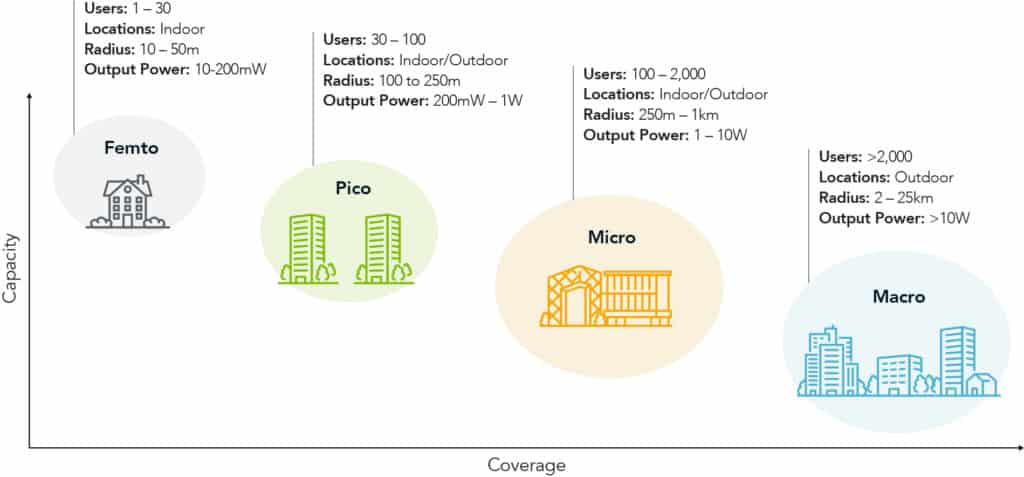Recognizing the Challenges of Indoor 5G Network Deployment
By Adam Smith
October 9, 2024
The telecommunication industry is more than six years into the deployment of 5G networks. It’s safe to say that 5G has achieved a relative state of maturity, and it’s now everywhere, particularly across North America.
But one area where 5G has underperformed is indoor deployment.
The problem is evident every time you walk into a Home Depot, Walmart or other big box retailer. The cell coverage is usually terrible, because 5G has largely been deployed outdoors – meaning that the phone has to talk to a base station that’s located outside of the building.
It’s all down to the basic physics of radio waves. 5G uses cellular bands with higher frequencies than the older 4G 700MHz band, and 5G radio signals simply don’t penetrate objects and buildings as well as 4G LTE frequencies. This means that 4G LTE offers better range and coverage but lacks the bandwidth of 5G – and that’s the trade-off.

The Promise and Limitations of Mid-Band 5G
5G has always been talked about as a heterogeneous network. It’s evolved into low-band (sub-1GHz) for coverage and high-band (mmWave/2839GHz) for higher data rates.
Then there is mid-band 5G (3.4-3.6GHz), which was introduced over the past two to four years.
Mid-band is the Goldilocks spectrum for outdoor coverage, because it’s more practical to deploy than mmWave and it has substantially more bandwidth than low-band. It was a huge upgrade for the wireless carriers, because only 10-20MHz of spectrum is available in the 700MHz band, but as much as 100MHz opens up at 3.5GHz – which yields up to a 10X capacity improvement.
Mid-band been very useful for the carriers but has had limited success improving indoor coverage.
Private 5G Cellular Networks Offer a Solution
The obvious way to address the gap in indoor coverage would be to deploy 5G cells indoors. This can be achieved with “small cells” and “femtocells,” which are compact, short-range base stations that can be positioned throughout a shopping mall or large building to fill indoor 5G coverage gaps.

While these small cell base stations can solve the technical issues of indoor coverage, the problem now is deciding who pays for their deployment. In the U.S., for example, this could require an indoor 5G base station for at least each of the top three wireless carriers – AT&T, T-Mobile and Verizon – with a similar issue arising in other countries.
As they strive to provide the best user experience possible, carriers could invest in an agnostic network that avoids duplication of base stations, but this would require the industry to coalesce around a common platform – an issue that has yet to gain momentum.
Getting to a state that is more or less “carrier neutral” may inadvertently take the industry down the road of a private 5G network, where organizations outside of incumbent carrier networks provide the infrastructure for 5G coverage.
The Cost Conundrum
While private networks sidestep the carrier issues, the challenge with indoor small cell deployment is one of cost. A big box retailer is unlikely to install a private 5G network just because their customers are getting bad indoor coverage. The concept of building-in support for a neutral host just isn’t part of their business model.
However, in a recent survey commissioned by Nokia, private 5G networks appear to be delivering positive results for the companies that deploy them, and there is impressive growth in the number and scale of deployments. It’s a hopeful sign that private networks can solve the indoor coverage problem for 5G.
Will a 5G-to-Wi-Fi Hand-Off Solve the Indoor Cellular Coverage Problem?
What about the convenience of Wi-Fi, which many of us connect to at home automatically? There is a similar experience using Wi-Fi in the car, which seamlessly hands calls over to the cellular network.
Unfortunately, that concept of roaming doesn’t exist with today’s indoor service. Even the availability of consortia such as the WBA OpenRoaming federation requires users to sign up for and log into the service, which creates friction for the user compared to the instant point-to-point mobility of cellular.
The ease of mobility comes at a cost, and in the end the reason why big box stores deploy Wi-Fi is that it’s relatively inexpensive and has become a convenience that consumers expect. What the cellular industry has yet to achieve is to reach the point where the capital costs required to ensure ubiquitous indoor 5G coverage are on par with private enterprise Wi-Fi networks.
What the Future Holds
In areas where both 4G and 5G coverage are available but the 5G signal is weak, users may find they’ve inadvertently been “traded down” to 4G service. For instance, if they try to surf a visually-dense web page to learn more about a store’s product using 4G service, the consumer experience is likely to be a bad one.

That’s also where O-RAN can close the gap between 5G and Wi-Fi by driving higher 5G integration, lower power consumption and lower cost. Carriers can also achieve these benefits by separating the cell site from the actual radio unit. Imagine a centralized core network where the radio is a simple optical or Ethernet connection that’s cheaper to deploy than bringing the entire cell site infrastructure indoors. It’s almost like a data server for telecom.
And that’s where we stand today. We have tools to solve the technical challenges for indoor 5G, with O-RAN potentially providing a welcome boost to private network deployment. What remains to be seen is whether or not the pain of poor indoor coverage is great enough to overcome the underlying deployment costs.
Categories
Subscribe to the LitePoint Blog
Related Posts


